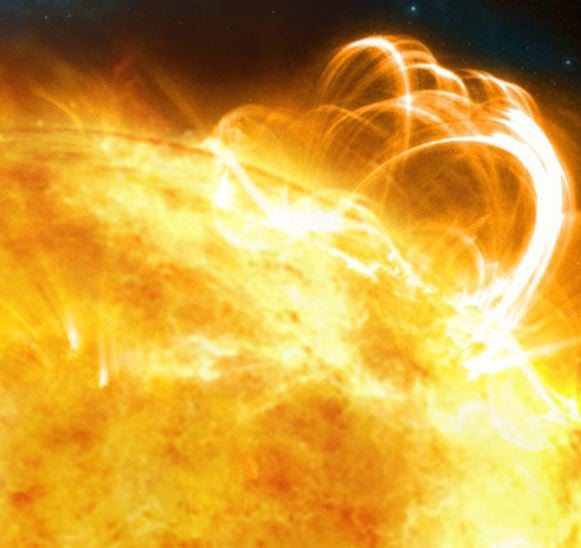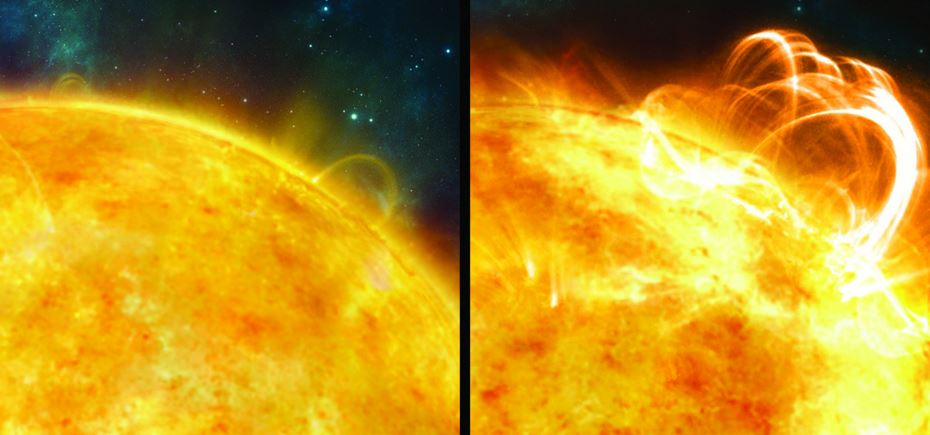A Sun superflare with the energy equivalent of a 100 billion megaton bomb could cause disaster on Earth – it could severely disrupt our power supply, plus GPS and radio communication systems, says a team of scientists led by the University of Warwick in England.
Lead researcher, Chloë Pugh, who works at the University of Warwick’s Centre for Fusion, Space and Astrophysics, and colleagues wrote about their study and conclusions in The Astrophysical Journal Letters.
The astrophysicists say they found a stellar superflare on a star that NASA’s Kepler space telescope had observed, with wave patterns similar to those that have been detected in our Sun’s flares.
 What our Sun might look like if it produced a superflare. A large flaring coronal loop structure is shown towering over a solar active region. (Image: University of Warwick)
What our Sun might look like if it produced a superflare. A large flaring coronal loop structure is shown towering over a solar active region. (Image: University of Warwick)
Superflares are ultra-massive flares
Superflares are mega explosions observed on solar-like stars with energy production rates several thousand times more powerful than that of solar-like flares.
This binary star, called KIC9655129, is in our galaxy (Milky Way) and is known to superflare. As its superflares and the Sun’s solar flares are similar, they probably share the same underling physics of flares, which supports the idea that our Sun has the capacity to produce a superflare, the authors suggest.
A typical solar flare has the energy-equivalent of a 100 million megaton bomb. A superflare on our Sun, however, could release the energy equivalent of a 100 billion megaton bomb.
 An artist’s impression of the ‘quiet’ Sun (left) and with a superflare (right). (Image: University of Warwick)
An artist’s impression of the ‘quiet’ Sun (left) and with a superflare (right). (Image: University of Warwick)
If our Sun produced a superflare, communications and energy systems on Earth could be at serious risk of failing.
Ms. Pugh, a PhD student, explained:
“Our solar system is filled with plasma, or ionised gas, originating from the Sun as a result of the solar wind and other more violent solar eruptions, such as solar flares. Stars very similar to the Sun have been observed to produce enormous flares, called superflares. To give us a better indication of whether the Sun could produce a catastrophic superflare, we need to determine whether the same physical processes are responsible for both stellar superflares and solar flares.”
“Solar flares are commonly observed to consist of a series of regularly occurring pulses. Often these pulsations resemble waves, with a wavelength that relates to various properties of the region of the Sun that is producing the flare. The study of waves such as these is referred to as coronal seismology.”
“Occasionally solar flares contain multiple waves superimposed on top of one another, which can easily be explained by coronal seismology. We have found evidence for multiple waves, or multiple periodicities, in a stellar superflare, and the properties of these waves are consistent with those that occur in solar flares.”
Sun superflare would be catastrophic for life on Earth
The authors say that if a superflare were produced by the Sun, the consequences could be disastrous for life on Earth. Our radio communications systems would be severely disrupted and there would be power blackouts across the world as a result of strong electrical currents being induced in our power grids.
“Fortunately the conditions needed for a superflare are extremely unlikely to occur on the Sun, based on previous observations of solar activity,” Ms. Pugh added.
In this study, the scientists used time series analysis to detect wave patterns within the light curve of a flare that came from KIC9655129, using data gathered by the Kepler space telescope.
Co-author, Dr Anne-Marie Broomhall, also from the University of Warwick, said:
“When a flare occurs we typically see a rapid increase in intensity followed by a gradual decline. Usually the decline phase is relatively smooth but occasionally there are noticeable bumps, which are termed ‘quasi-periodic pulsations’ or QPPs. We used techniques called wavelet analysis and Monte Carlo modelling in order to assess the periodicity and statistical significance of these QPPs.”
The scientists’ analysis revealed two significant periodicities, with a less than one percent chance that these pulsations would be observed by chance.
Dr Broomhall explained:
“We then fitted a model to the flare light curve that described both the exponential decay phase and the two periodicities. The periods were found to be 78 minutes and 32 minutes respectively. The properties of the periodicities, such as their decay times, imply that the two periodicities are independent.”
“The most plausible explanation for the presence of two independent periodicities is that the QPPs were caused by magnetohydrodynamic (MHD) oscillations, which are frequently observed in solar flares. This result is, therefore, an indication that the same physical processes are involved in both solar flares and stellar superflares. The latter finding supports the hypothesis that the Sun is able to produce a potentially devastating superflare.”
The study was funded by a European Research Council project led by Professor Valery M. Nakariakov.
Citation: “A MULTI-PERIOD OSCILLATION IN A STELLAR SUPERFLARE,” C. E. Pugh, V. M. Nakariakov and A.-M. Broomhall. The Astrophysical Journal Letters, Volume 813, Number 1. DOI: 10.1088/2041-8205/813/1/L5.
Video – Powerful superflare from mini star detected
This NASA video explains how powerful a mega flare (superflare) was. It was detected by the SWIFT satellite.
